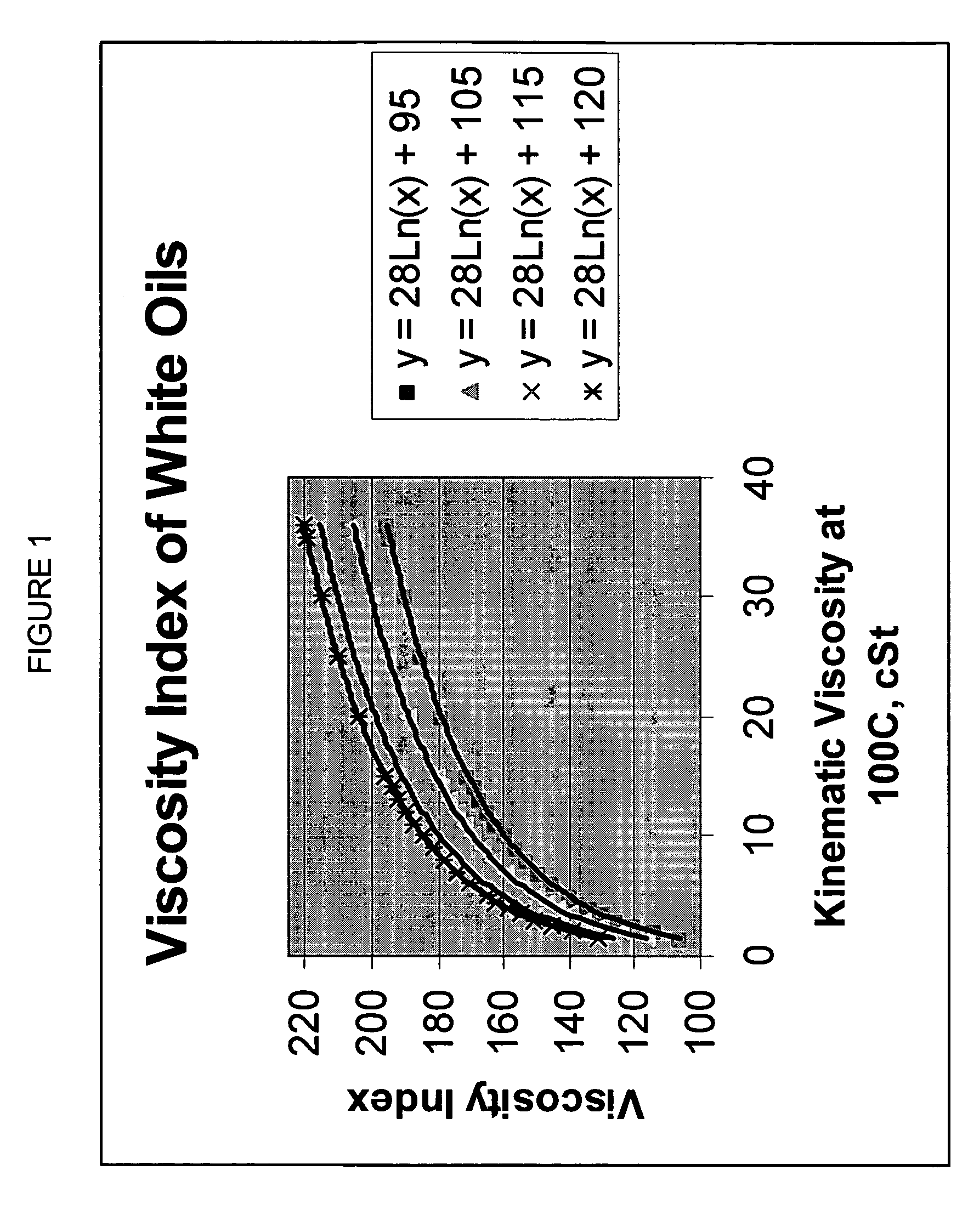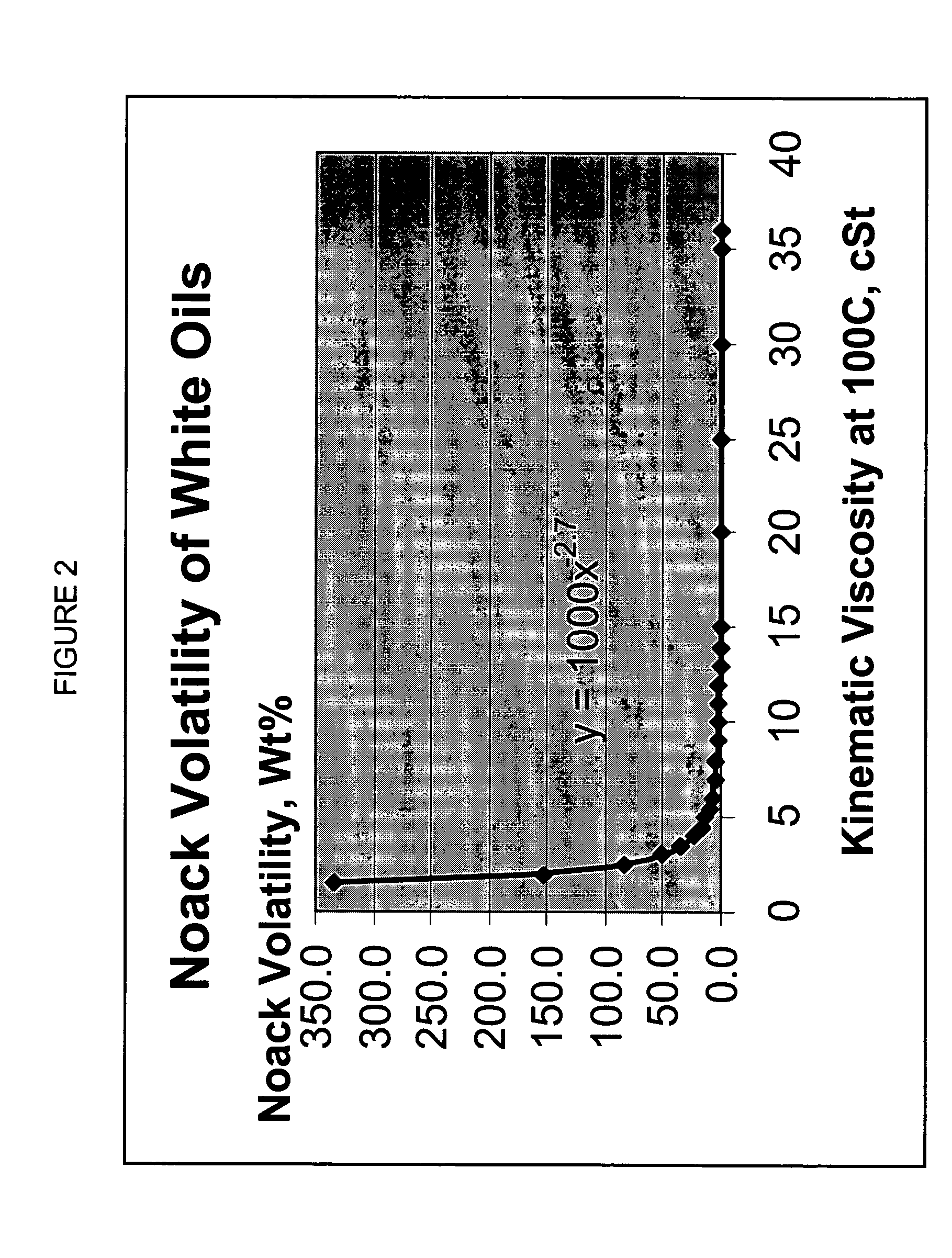Process to make white oil from waxy feed using highly selective and active wax hydroisomerization catalyst
a technology of active wax hydroisomerization and white oil, which is applied in the direction of hydrocarbon oil treatment products, petroleum wax refining, petroleum chemical modification, etc., can solve the problems of high commercial value of white oil, high cost of production, and inability to optimize the process to produce high yields of white oil
- Summary
- Abstract
- Description
- Claims
- Application Information
AI Technical Summary
Benefits of technology
Problems solved by technology
Method used
Image
Examples
example 1
[0077]A hydrotreated Fischer-Tropsch wax made over a cobalt Fischer-Tropsch catalyst, having greater than 80 weight percent n-paraffins, less than 0.8 weight percent oxygen, and a T90 boiling point of 972° F. was selected for hydroisomerization dewaxing into white oil. The hydrotreated Fischer-Tropsch wax had less than 25 ppm total combined nitrogen and sulfur, and less than 25 ppm total combined aluminum, cobalt, titanium, iron, molybdenum, sodium, zinc, tin, and silicon. The hydrotreated Fischer-Tropsch wax had greater than 30 weight percent of molecules having at least 30 carbon atoms. The hydrotreated Fischer-Tropsch wax had a weight ratio of molecules having at least 60 or more carbon atoms and molecules having at least 30 carbon atoms less than 0.05.
example 2
[0078]The hydrotreated Fischer-Tropsch wax described in Example 1 was hydroisomerization dewaxed over a highly selective and active wax hydroisomerization catalyst containing 65 wt % SSZ-32 zeolite and a noble metal hydrogenation component, Pt, on a refractory oxide support. The hydroisomerization dewaxing was conducted at a temperature of 600° F., LHSV of 1 hr−1, 300 psig total pressure, and 5,000 SCF / bbl once-through hydrogen. The white oil produced by the hydroisomerization dewaxing passed directly to a second reactor, also at 300 psig total pressure, which contained a Pt / Pd on silica-alumina hydrofinishing catalyst. Conditions in the hydrofinishing reactor were a temperature of 450° F. and LHSV of 2.0 hr1. The yield of products boiling at 343 degrees C. and higher (650° F.+) out of the hydrofinishing reactor was about 57 wt % of the hydrotreated Fischer-Tropsch wax feed into the hydroisomerization reactor. The conversion of products boiling at 343 degrees C. and higher (650° F.+...
example 3
[0082]RCS tests were performed on the whole 650° F.+ and 730-970° F. distillation cut white oils described in example 2. Neither of these white oils passed the RCS test. Subsequent hydrofinishing was conducted on these two samples. The hydrofinishing conditions were the same as those used previously except the total pressure was increased from 300 psig to 500 psig or 1000 psig. These white oils prepared by subsequent hydrofinishing at pressures higher than about 325 psig passed the stringent RCS test. The results of the analyses conducted on all of the white oil samples are summarized in Table IV
[0083]
TABLE IVWhite Oil SamplesWhite Oil InspectionsWhole ProductDistillation CutSampleWhole 650° F.+Whole 650° F.+Whole 650° F.+730-970° F.730-970° F.Hydroisomerization300300300300300Dewaxing TotalPressure, psigMild Hydrofinishing300300300300300Total Pressure, psigSubsequentNone5001000None1000Hydrofinishing TotalPressure, psigPour Point, ° C.−29−17Viscosity, 40° C., cSt20.3619.19Viscosity 1...
PUM
| Property | Measurement | Unit |
|---|---|---|
| crystallographic free diameter | aaaaa | aaaaa |
| crystallographic free diameter | aaaaa | aaaaa |
| weight percent | aaaaa | aaaaa |
Abstract
Description
Claims
Application Information
 Login to View More
Login to View More - R&D
- Intellectual Property
- Life Sciences
- Materials
- Tech Scout
- Unparalleled Data Quality
- Higher Quality Content
- 60% Fewer Hallucinations
Browse by: Latest US Patents, China's latest patents, Technical Efficacy Thesaurus, Application Domain, Technology Topic, Popular Technical Reports.
© 2025 PatSnap. All rights reserved.Legal|Privacy policy|Modern Slavery Act Transparency Statement|Sitemap|About US| Contact US: help@patsnap.com


